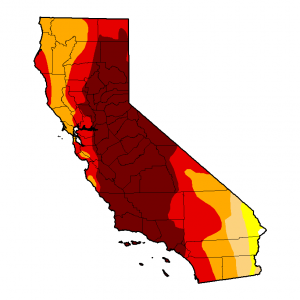Preparing for a lecture for next week for the University of New Mexico Water Resources Program class I’m co-teaching, I’m having the students read this piece by my drought guru Kelly Redmond:
Most concepts of drought involve a water balance. This implies that both supply and demand must be considered, as well as the question of whether there is “enough” (and, enough for what?). Thus, through time I have come to favor a simple definition; that is, insufficient water to meet needs. (emphasis added)
I’ll be talking some of the quantitative drought metrics, like the Palmer Drought Severity Index, or the Standardized Precipitation Index, or How Much Water Is In That Big Reservoir. But Kelly’s point is that the key is to understand how systems (people, ecosystems, etc.) are actually using the water. This helps clarify what we mean by “drought” beyond simply “OMG look at that big ugly red Drought Blob of Death that landed on California!”
A second reading assignment is a new white paper by Ellen Hanak and colleagues at the Public Policy Institute of California that does the clarifying work by getting specific about the question of who’s really being forced to go without water, or facing reduced supplies of water, or creating future risks. Hanak and colleagues push this forward with a useful thought experiment: what if California’s drought continues?
Given the pervasive nature of the red blob in public discourse, one important starting point is the PPIC team’s observation that California’s major municipal areas are doing pretty well, and should continue to do so:
Urban areas are in the best shape, thanks to sustained investments in diversified water portfolios and conservation.
Farmers, they note, have done remarkably well in adapting, especially by crop shifting and fallowing, though excessive groundwater pumping, especially in the Central Valley, may be adaptive in the short run and maladaptive in the long run, what with the surface of the earth actually sinking because they’re pumping so much and so on.
The two greatest problem areas the PPIC team found are rural communities and natural systems. Rural communities lack the resources of L.A. or San Francisco to buy their way into deeper resilience:
Many rural households rely on shallow domestic wells or small, poorly funded community water supply systems.
Natural systems also are suffering:
The most acute and severe impacts of this drought so far are on California’s freshwater habitats and forested lands and on the biodiversity they support. These impacts stem, in part, from the severity of the drought and its combination of low flows and heat. More than a century of water and land practices have increased vulnerability by undermining the natural capacity of these ecosystems to handle occasional droughts.
The environment doesn’t have the same kinds of adaptation tools as other sectors—it generally can’t pump more groundwater in dry times, for example. But this troubling situation also reflects less investment in building drought resilience for the environment. California was unprepared for this environmental drought emergency and is now struggling to implement stopgap measures.
As a communicator, I’ve long struggled with the inadequacies of the word “drought” for two reasons. The first is its binary nature – we’re either in it or we’re not. “Is the drought over?” That’s wrong, but pervasive, because when it’s used out in the wild, in public discourse, I can’t control the meanings regular people take from the word. The second is its hidden imprecision. We use it in water policy and practice discussions without realizing that we may be using the same word but not meaning the same thing. Trying to unpack the word and explain its many shades of meaning for the WRP students is therefore a really fun exercise.



With all due respect to my Drought Monitor associate Kelly Redmond, I disagree with the simple, even simplistic, definition of drought you quoted. I would also note it appeared over a decade ago. I’ll have to ask if his opinion has changed in the interim. In any case, as Edward Abbey wrote, “There is no lack of water here, unless you try to establish a city where no city should be.” In other words, “insufficient water to meet needs” is one dimensional representation of what everyone agrees is a multidimensional phenomenon, and if the dimension is “need” then the chosen variable is too elastic to be a reliable gauge, rather like trying to build a bookcase using a very stretchy tape measure to determine the length of each shelf.